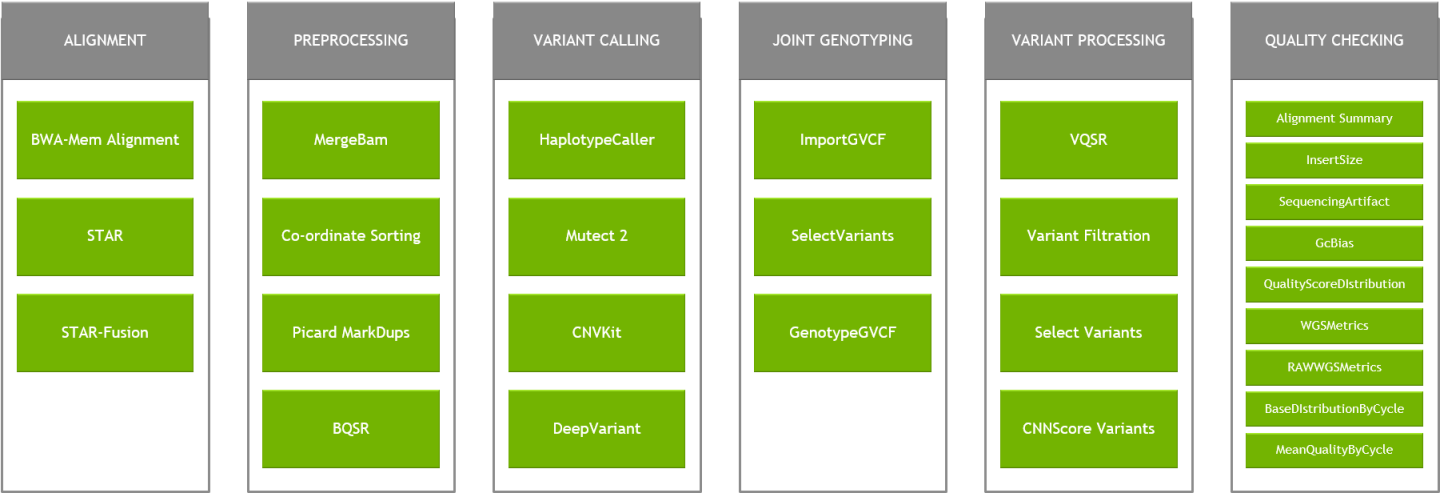NVIDIA CLARA PARABRICKS PIPELINES
Parabricks is a software suite for performing secondary analysis of next generation sequencing (NGS) DNA data. A major benefit of Parabricks is that it is designed to deliver results at blazing fast speeds and low cost. Parabricks can analyze whole human genomes in about 45 minutes, compared to about 30 hours for 30x WGS data. The best part is the output results exactly match the commonly used software. So, it’s fairly simple to verify the accuracy of the ouput.
Under the hood, it achieves this performance through tight integration with GPUs, which excel at performing data parallel computation much more effectively than traditional CPU-based solutions. Parabricks was built from the ground up by GPU computing and Deep Learning experts who wanted to develop the fastest and most efficient possible implementation of common genomics algorithms used in secondary analysis.
You can learn more at https://developer.nvidia.com/clara-parabricks
Parabricks is a software suite for genomic analysis. It delivers major improvements in throughput time for common analytical tasks in genomics, including germline and somatic analysis. The core of the Parabricks software is its data pipeline which takes raw data and transoforms it according to the user’s requirements.
The Parabricks software supports the pipeline shown below:

The Parabricks software can be configured to run specific accelerated tools or run full pipelines that are commonly used. The standalone tools page covers individual tools and the pipelines page discuss how to run commonly used pipelines.
NVIDIA Parabricks’ pipelines have been tested on Dell, HPE, IBM, and NVIDIA servers at Amazon Web Services, Google Cloud, Oracle Cloud Infrastructure, and Microsoft Azure.
The following standalone tools can be used with the NVIDIA Clara Parabricks Pipelines software. Please click on the tool names for tool specific options.
Tool |
Details |
Align using bwa-mem, co-ordinate sort and mark duplicates, optionally you can run bqsr. |
|
Collect BQSR report on a bam file |
|
Apply BQSR report on a bam file to generate new bam file |
|
GPU-HaplotypeCaller for calling germline variants |
|
GPU-Mutect2 for tumor-normal analysis |
|
GPU-DeepVariant for calling germline variants |
|
Collect WGS Metrics on a bam file |
|
Collect multiple classes of metrics for a bam file |
|
Filter variants using Convolutional Neural Network |
|
Build a recalibration model to score variant quality and apply a score cutoff to filter variants |
|
Combine GVCF of 2 or 3 samples |
|
Start a genomic database for multiple samples |
|
Add samples to a genomic database |
|
Select variants from database and create a gvcf |
|
Index a vcf/gvcf file |
|
Convert a gvcf to vcf |
|
Mapping RNA reads to a reference, using a two-pass mode to get better alignments around novel splice junctions. |
|
Uses the STAR aligner to identify candidate fusion transcripts. |
The following standalone pipelines can be used with the NVIDIA Clara Parabricks Pipelines software. Please click on the tool names for tool specific options.
Pipeline |
Functionality |
Detect germline variants for a given sample from fastq files. Compatible with GATK4 best practices. |
|
Detect germline variants for a given sample from fastq files with correct ploidy values for human sex chromosome handling. Compatible with GATK4 best practices. |
|
Detect somatic variants for a given tumor/normal fastq files. Compatible with GATK4 best practices. |
|
Use GenomicsDB to run accelerated Joint Variant Calling. |